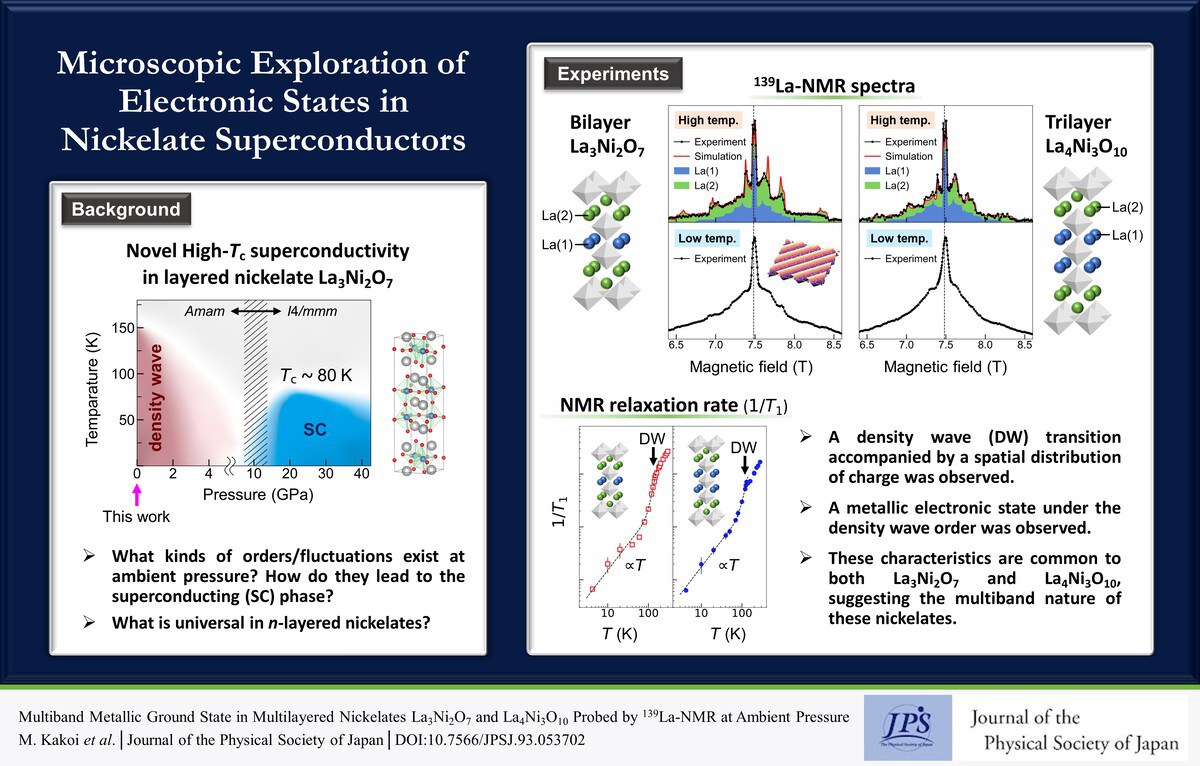Microscopic Exploration of Electronic States in Nickelate Superconductors
© The Physical Society of Japan
This article is on
Multiband Metallic Ground State in Multilayered Nickelates La3Ni2O7 and La4Ni3O10 Probed by 139La-NMR at Ambient Pressure
(JPSJ Editors' Choice)
J. Phys. Soc. Jpn. 93, 053702 (2024).
The multilayered nickelates, La3Ni2O7 and La4Ni3O10 , were investigated using nuclear magnetic resonance (NMR) at ambient pressure. Metallic electronic states under the density wave order were observed microscopically for both compounds.

In 2023, the discovery of the superconductivity of La3Ni2O7 with a transition temperature (Tc) of ~80 K under pressure led to nickelates joining the family of high-Tc superconductors. La3Ni2O7 has a two-layered perovskite structure resembling cuprates, which are well-known high-Tc superconductors. However, it actually possesses different characteristics from those of cuprates, anticipating a new superconducting mechanism.
One of the major mysteries of La3Ni2O7 is what kind of electronic orders and/or fluctuations exist and how they lead to the superconducting phase from the non-superconducting phase at ambient pressure. In addition, La3Ni2O7 belongs to the Ruddlesden–Popper (RP) phase Lan+1NinO3n+1, which includes similar compounds with different numbers of layers (n). Systematic studies of the RP series are expected to provide clues regarding the origin of superconductivity and the exploration of new superconductors.
We investigated the electronic states of (La3Ni2O7) (n=2) and La4Ni3O10 (n=3) at ambient pressure using nuclear magnetic resonance (NMR) experiments, which can be used to microscopically observe the orders and/or fluctuations of charge and spin. The NMR spectra at high temperatures exhibited multiple distinct peaks, which allowed us to identify two crystallographically inequivalent sites. At temperatures below 150 K for La3Ni2O7 and 130 K for La4Ni3O10, significant broadening of their spectra, particularly in the satellite peaks, was observed. This suggests the existence of a density-wave transition accompanied by a spatial charge distribution. We also measured the nuclear spin relaxation rate (1/T1), showing that, in addition to the sharp drop in 1/T1 associated with the density wave transition, the relaxation remains finite at lower temperatures. This result indicates that the system has a metallic ground state with a partial gap at the Fermi energy owing to the density-wave transition.
The fact that these characteristics are commonly observed in La3Ni2O7 and La4Ni3O10 provides important insights. These observations are likely associated with the different features of the multiple bands composed of the dx2-y2 and d3z2-r2 orbitals, which are common to these compounds. Recently, superconductivity with a of ~25 K under pressure was also discovered in La4Ni3O10. This finding suggests a connection between the multiband nature, density wave phase, and emergence of the superconducting phase under high pressure. The possibility of spin order coexisting with charge order remains debatable, and further investigations are required to understand how the charge and spin degrees of freedom evolve toward the superconducting phase under high pressure.
Written by M. Kakoi and H. Mukuda on behalf of all authors.
Multiband Metallic Ground State in Multilayered Nickelates La3Ni2O7 and La4Ni3O10 Probed by 139La-NMR at Ambient Pressure
(JPSJ Editors' Choice)
J. Phys. Soc. Jpn. 93, 053702 (2024).
Share this topic
Fields
Related Articles
-
Electricity Provides Cooling
Magnetic properties in condensed matter
Structure and mechanical and thermal properties in condensed matter
Cross-disciplinary physics and related areas of science and technology
2024-10-15
Electric cooling at low temperatures is successfully achieved using a ferroelectric ferromagnetic solid instead of refrigerant gases such as fluorocarbons.
-
Pressure-Tuned Classical–Quantum Crossover in Magnetic Field-Induced Quantum Phase Transitions of a Triangular-Lattice Antiferromagnet
Magnetic properties in condensed matter
Electron states in condensed matter
Cross-disciplinary physics and related areas of science and technology
2024-9-5
The correspondence principle states that as quantum numbers approach infinity, the nature of a system described by quantum mechanics should match that described by classical mechanics. Quantum phenomena, such as quantum superposition and quantum correlation, generally become unobservable when a system approaches this regime. Conversely, as quantum numbers decrease, classical descriptions give way to observable quantum effects. The external approach to classical–quantum crossover has attracted research interest. This study aims to demonstrate a method for achieving such control in materials.
-
The Mysterious Superconductivity of Sr2RuO4
Superconductivity
2024-8-22
Researchers review the recent advancements made towards solving the mysteries of the unconventional superconductivity of Sr2RuO4, analyzing recent experiments and theoretical models and proposing approaches to resolve current challenges.
-
Discovery of Unconventional Pressure-Induced Superconductivity in CrAs
Superconductivity
Electronic transport in condensed matter
2024-8-13
A new study has discovered pressure-induced superconductivity in the helimagnet CrAs, originating in the vicinity of the helimagnetic ordering, representing the first example of superconductivity in Cr-based magnetic systems.
-
Unification of Spin Helicity in the Magnetic Skyrmion Lattice of EuNiGe3
Magnetic properties in condensed matter
2024-8-7
In the magnetic skyrmion lattice of non-centrosymmetric EuNiGe3, the original magnetic helicity, determined by the antisymmetric exchange interaction, is reversed, resulting in a unified helicity.
